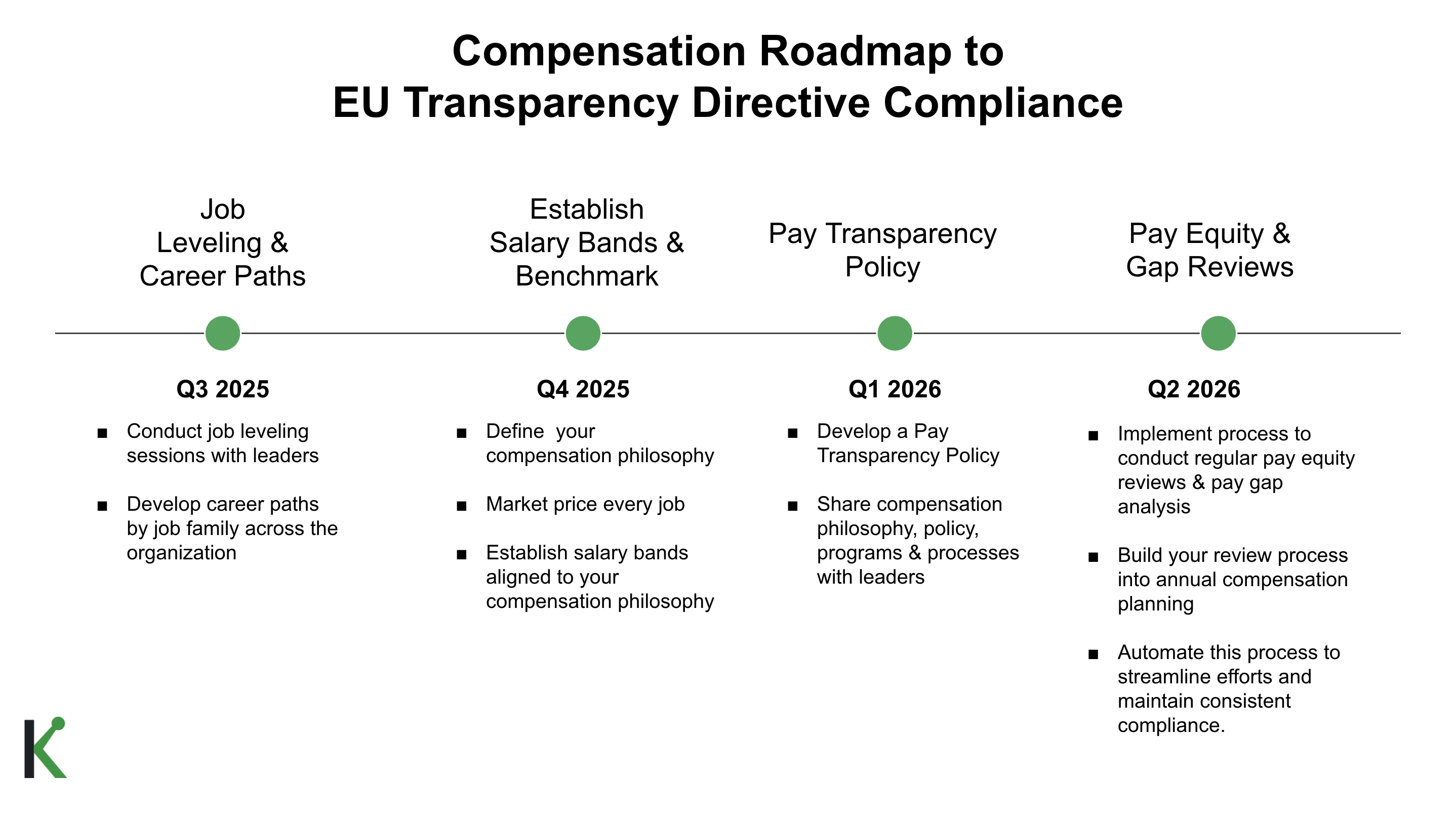
Roadmap to EU Pay Transparency Directive Compliance
Step-by-step roadmap to comply with the EU Pay Transparency Directive by June 2026. Learn how to build job levels, set salary bands, draft policies, review pay equity, and communicate changes to employees.With the EU Pay Transparency Directive taking effect in June 2026, employers with employees across Europe have a new mandate: create fairer, more transparent compensation practices that address pay equity.
Aligning your organization with these new requirements will take time and careful planning.
This step-by-step roadmap outlines key compensation initiatives, broken down by timeline, to guide you toward compliance.
1. Conduct Job Leveling & Career Paths (By Q3 2025)
Kick off your compliance journey by building a clear job architecture and conducting job levels across your organization.
Define each role's requirements, responsibilities, and skills while creating consistent job titles and career paths that support both employee growth and business needs.
Developing this foundation will ensure you're well-positioned to implement the EU Directive's requirements.
Tip: Review employees' job levels at least 2 times a year to ensure accuracy and review career paths at least annually to ensure alignment with business needs.
Reach out to Kamsa to leverage our market-friendly job level descriptions and take job leveling off your plate!
2. Establish Salary Bands & Benchmark (Q4 2025)
Once levels and roles and levels are clearly defined, use this framework to benchmark each position. With market-based data from reliable sources like Kamsa, create fair, competitive salary bands aligned to your company's compensation philosophy. This not only prepares you for transparency requirements but also builds trust with employees by showing that pay is data-driven and equitable.
Tip: Use Kamsa to 'document' and manage your salary bands so they are readily available to be able to explain and defend.
3. Draft Pay Transparency Policy (Q1 2026)
By the middle of 2025, draft an internal policy on pay transparency. It should outline your organization’s commitment to fair pay practices and include a clear process for employees to request pay information as allowed by the Directive. Having these policies in place supports trust and prepares your organization for audits or inquiries into pay practices.
Tip: Consult with your expert legal advisors to ensure your policy aligns with both EU and national regulations.
4. Pay Equity & Gap Reviews (Q2 2026)
Set up a schedule for regular pay equity assessments, ideally aligning with your annual compensation planning. While the Directive mandates pay equity reviews at least every three years, conducting them annually ensures that your organization is always up-to-date and able to address any changes in a more efficient way.
Conduct any pay gap analysis will highlight any discrepancies in pay across gender and other demographics. Then, use this data to develop goals that align with the Directive’s focus on transparency and equality.
Tip: Automate this process via a tool like Kamsa to streamline pay equity and pay gap analyses and maintain consistent compliance.
5. Educate and Communicate with Employees (Q1-Q2 2026)
Transparency isn’t just about numbers – it’s about trust. As you finalize compliance, be proactive in communicating these changes to employees. Explain what the Directive means, how your company is responding, and why these measures matter for the company.
Tip: Consider hosting informational sessions or creating an FAQ document to ensure employees feel informed and supported.
By following this roadmap, your organization will not only be prepared for compliance by June 2026 but will also foster a culture of fairness and trust that supports long-term retention, employee satisfaction, and even enhanced productivity.
Timeline Recap:

Taking these steps now will position your organization not only to meet compliance requirements but to build a reputation as a fair and desirable workplace.


